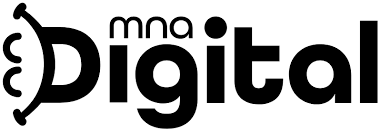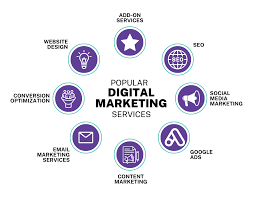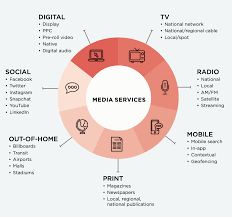Digital Media Advertising: Reaching New Heights in Marketing
In today’s fast-paced digital world, advertising has evolved significantly. With the rise of technology and the internet, traditional advertising methods are no longer sufficient to reach and engage with the target audience effectively. This has given birth to a powerful tool known as digital media advertising.
The Power of Digital Media Advertising
Digital media advertising encompasses a wide range of strategies used to promote products or services through various online platforms. These platforms include websites, social media networks, search engines, mobile applications, and more. The effectiveness of digital media advertising lies in its ability to target specific demographics and reach a massive audience instantaneously.
One of the key advantages of digital media advertising is its ability to provide highly targeted campaigns. Through advanced analytics and data collection tools, advertisers can gather valuable insights about their audience’s preferences, interests, and behaviors. This information allows them to create personalised and relevant advertisements that resonate with their target market.
The Benefits of Digital Media Advertising
Enhanced Reach: Unlike traditional media channels with limited reach, digital media advertising allows businesses to connect with a global audience. With billions of people using the internet daily, the potential reach is virtually limitless.
Cost-Effective: Digital media advertising offers various pricing models that suit different budgets. Whether it’s pay-per-click (PPC), cost-per-impression (CPM), or cost-per-action (CPA), businesses have the flexibility to choose the most cost-effective option that aligns with their marketing goals.
Real-Time Analytics: Unlike traditional advertising methods, digital media advertising provides real-time analytics. Advertisers can track the performance of their campaigns, measure key metrics, and make data-driven decisions to optimize their strategies for better results.
The Future of Digital Media Advertising
As technology continues to advance, digital media advertising will only become more sophisticated and influential. Artificial intelligence (AI) and machine learning algorithms are revolutionizing the way advertisements are created and delivered. Personalized ads based on user preferences, voice-activated advertising, augmented reality experiences – these are just a glimpse of what the future holds.
Moreover, with the increasing popularity of mobile devices and social media platforms, mobile advertising and influencer marketing are expected to dominate the digital advertising landscape. The ability to target users based on their location and interests opens up endless possibilities for businesses to connect with their audience in a more meaningful way.
In Conclusion
Digital media advertising is transforming the marketing landscape by providing businesses with unprecedented opportunities to reach and engage with their target audience. By leveraging advanced targeting capabilities, real-time analytics, and innovative technologies, advertisers can create impactful campaigns that drive brand awareness, increase conversions, and ultimately boost business growth. As we move forward into a digitally-driven future, embracing digital media advertising will be crucial for companies seeking to stay competitive in today’s dynamic marketplace.
Mastering Digital Media Advertising: An Essential Guide to Strategy, Platforms, and Performance Measurement
- What is digital media advertising?
- How does digital media advertising work?
- What are the benefits of digital media advertising?
- Which platforms can be used for digital media advertising?
- How can I target my audience through digital media advertising?
- What are the different pricing models for digital media advertising?
- How can I measure the success of my digital media advertising campaigns?
- What are the future trends in digital media advertising?
What is digital media advertising?
Digital media advertising refers to the practice of promoting products or services through various online platforms, such as websites, social media networks, search engines, and mobile applications. It harnesses the power of technology and the internet to reach a vast audience instantaneously. Digital media advertising allows businesses to target specific demographics based on their preferences, interests, and behaviours. By leveraging advanced analytics and data collection tools, advertisers can create personalised and relevant advertisements that resonate with their target market. This form of advertising provides enhanced reach, cost-effectiveness, and real-time analytics, making it a powerful tool for businesses to connect with their audience in today’s digital age.
How does digital media advertising work?
Digital media advertising works by leveraging various online platforms and technologies to promote products or services to a targeted audience. It involves a strategic process that begins with identifying the target market and understanding their preferences, interests, and behaviors. Advertisers then create compelling and relevant ads tailored to this specific audience. These ads are displayed across different digital channels such as websites, social media networks, search engines, mobile applications, and more. Advanced analytics tools track the performance of these ads in real-time, allowing advertisers to measure key metrics and make data-driven decisions for optimization. By harnessing the power of digital media advertising, businesses can effectively reach their target audience, drive brand awareness, increase conversions, and ultimately achieve their marketing goals in today’s digital landscape.
What are the benefits of digital media advertising?
Digital media advertising offers numerous benefits for businesses looking to expand their reach and connect with their target audience. Firstly, it provides enhanced reach by allowing businesses to connect with a global audience through various online platforms. Secondly, digital media advertising is cost-effective, offering flexible pricing models that suit different budgets. Additionally, it provides real-time analytics, enabling advertisers to track campaign performance and make data-driven decisions for optimization. With these advantages, businesses can achieve better targeting, increased brand awareness, higher conversions, and ultimately drive growth in today’s competitive marketplace.
Which platforms can be used for digital media advertising?
When it comes to digital media advertising, there are numerous platforms available that can be leveraged to reach and engage with the target audience. Some of the most popular platforms include social media networks like Facebook, Instagram, Twitter, and LinkedIn. These platforms offer extensive targeting options and a vast user base, making them ideal for businesses of all sizes. Additionally, search engines like Google and Bing provide opportunities for search engine marketing (SEM) through paid search ads. Other platforms such as YouTube, mobile apps, display networks, and email marketing also play a significant role in digital media advertising strategies. The key is to carefully evaluate the target audience and their preferred online channels to determine the most effective platform for reaching them.
How can I target my audience through digital media advertising?
To effectively target your audience through digital media advertising, you need to leverage the power of data and analytics. Start by understanding your target market’s demographics, interests, and online behavior. This information can be gathered through various tools like website analytics, social media insights, and customer surveys. Once you have a clear understanding of your audience, you can create tailored campaigns that resonate with their preferences. Utilize targeting options provided by digital advertising platforms such as location-based targeting, interest-based targeting, and demographic targeting. By constantly analyzing the performance of your campaigns and making data-driven adjustments, you can refine your targeting strategies and ensure that your message reaches the right people at the right time, maximizing the effectiveness of your digital media advertising efforts.
What are the different pricing models for digital media advertising?
When it comes to digital media advertising, there are several pricing models that businesses can choose from. The most common ones include pay-per-click (PPC), where advertisers only pay when a user clicks on their ad; cost-per-impression (CPM), where advertisers pay for every thousand impressions their ad receives; and cost-per-action (CPA), where advertisers only pay when a specific action, such as a purchase or sign-up, is completed. These pricing models offer flexibility and allow businesses to tailor their advertising budgets according to their specific goals and objectives. By understanding the different pricing models available, businesses can make informed decisions about how to allocate their resources effectively in the realm of digital media advertising.
How can I measure the success of my digital media advertising campaigns?
Measuring the success of digital media advertising campaigns is essential to understand the effectiveness and return on investment (ROI) of your marketing efforts. There are several key metrics that can help you gauge the performance of your campaigns. Firstly, tracking website traffic and engagement through tools like Google Analytics can provide insights into the number of visitors, their behavior on your site, and conversion rates. Secondly, monitoring click-through rates (CTR) and conversion rates from your ads can indicate how well they are capturing audience attention and driving desired actions. Additionally, tracking social media engagement, such as likes, shares, and comments, can give you an indication of how well your content resonates with your target audience. By regularly analysing these metrics and comparing them against your campaign goals, you can make data-driven decisions to optimize future campaigns for even greater success.
What are the future trends in digital media advertising?
The future of digital media advertising is filled with exciting possibilities. As technology continues to advance, we can expect to see several key trends shaping the industry. One such trend is the rise of artificial intelligence (AI) and machine learning algorithms, which will revolutionize how ads are created and delivered. Personalized advertising based on user preferences and behaviors will become more prevalent, ensuring that ads resonate with individuals on a deeper level. Additionally, mobile advertising and influencer marketing are expected to dominate the digital landscape as more people rely on their smartphones and engage with social media platforms. The ability to target users based on their location and interests will open up new avenues for businesses to connect with their audience in a more meaningful way. Overall, the future of digital media advertising promises innovative technologies and strategies that will drive brand awareness, increase conversions, and shape the way businesses engage with their customers.




